Affiliate disclosure: This post may contain affiliate links. Please see our Privacy Policy.
Borage is a beautiful annual flower that’s popular with gardeners, mostly for its abundant display of showy blue flowers. It also happens to be both edible and medicinal, and it has a number of uses in the kitchen and around the house.
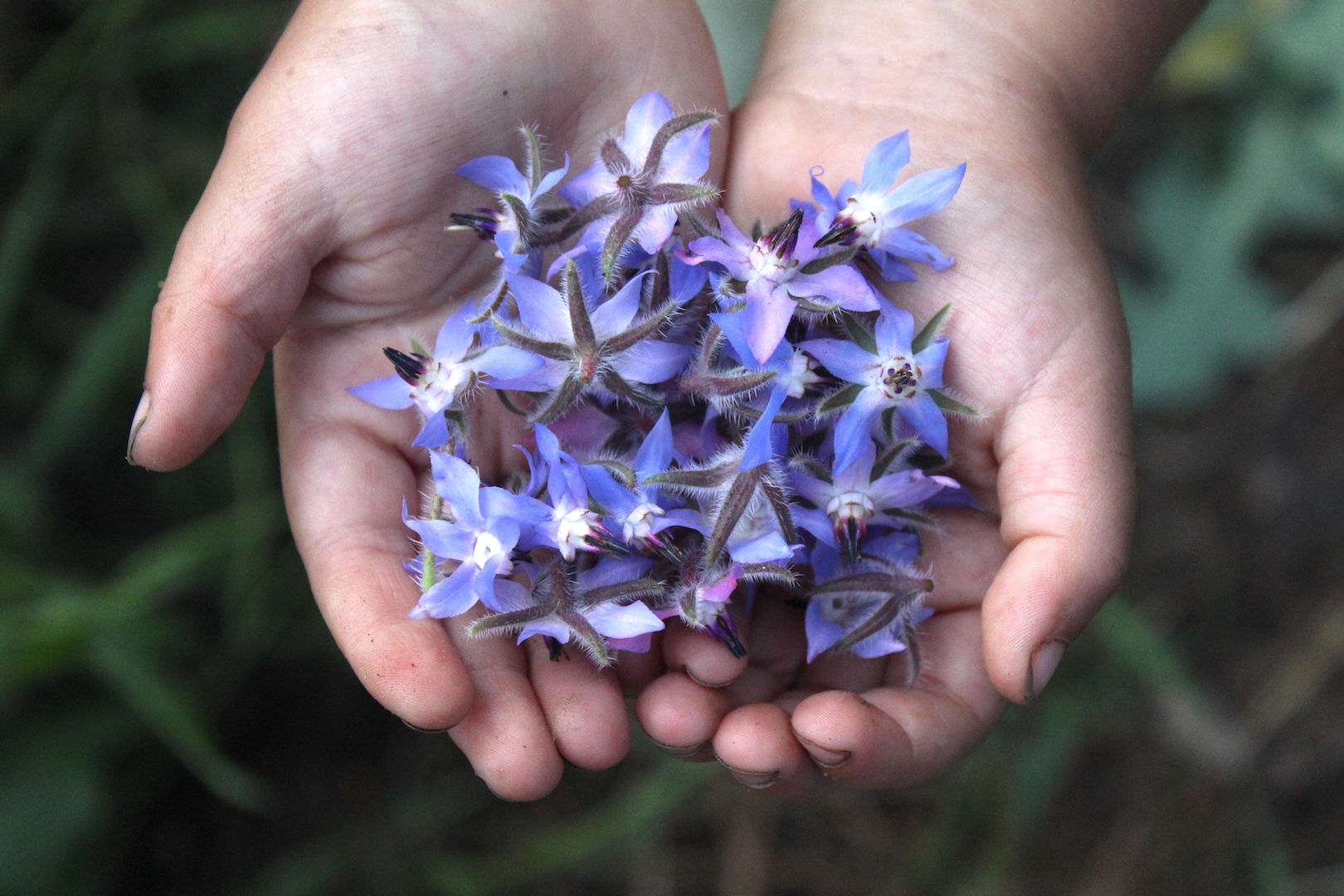
Table of Contents
- What is Borage?
- Borage Medicinal Properties
- Ways to Use Borage
- Borage Tea
- Borage Tincture
- Borage Infusion
- Borage Poultice
- Borage Infused Oil
- Borage Salve with Calendula and Lavender
- Cucumber Borage Soap
- Borage Recipes
- Borage Cucumber Jelly
- Ravioli Filled with Borage and Ricotta Cheese
- Borage Soup
- Borage Leaf, Pea, and Garden Mint Soup
- Borage Mint Dip
- Borage Lemonade
- Other Uses for Borage
- Herbal Guides
Borage is one of those underappreciated herbs from long-ago. While lots of gardeners grow it, few people know it as a medicinal herb (or edible flower). For the most part, it’s planted and simply enjoyed visually, which is a shame because there are so many ways to use borage.
It’s an old-fashioned plant that has a number of medicinal properties and culinary uses.
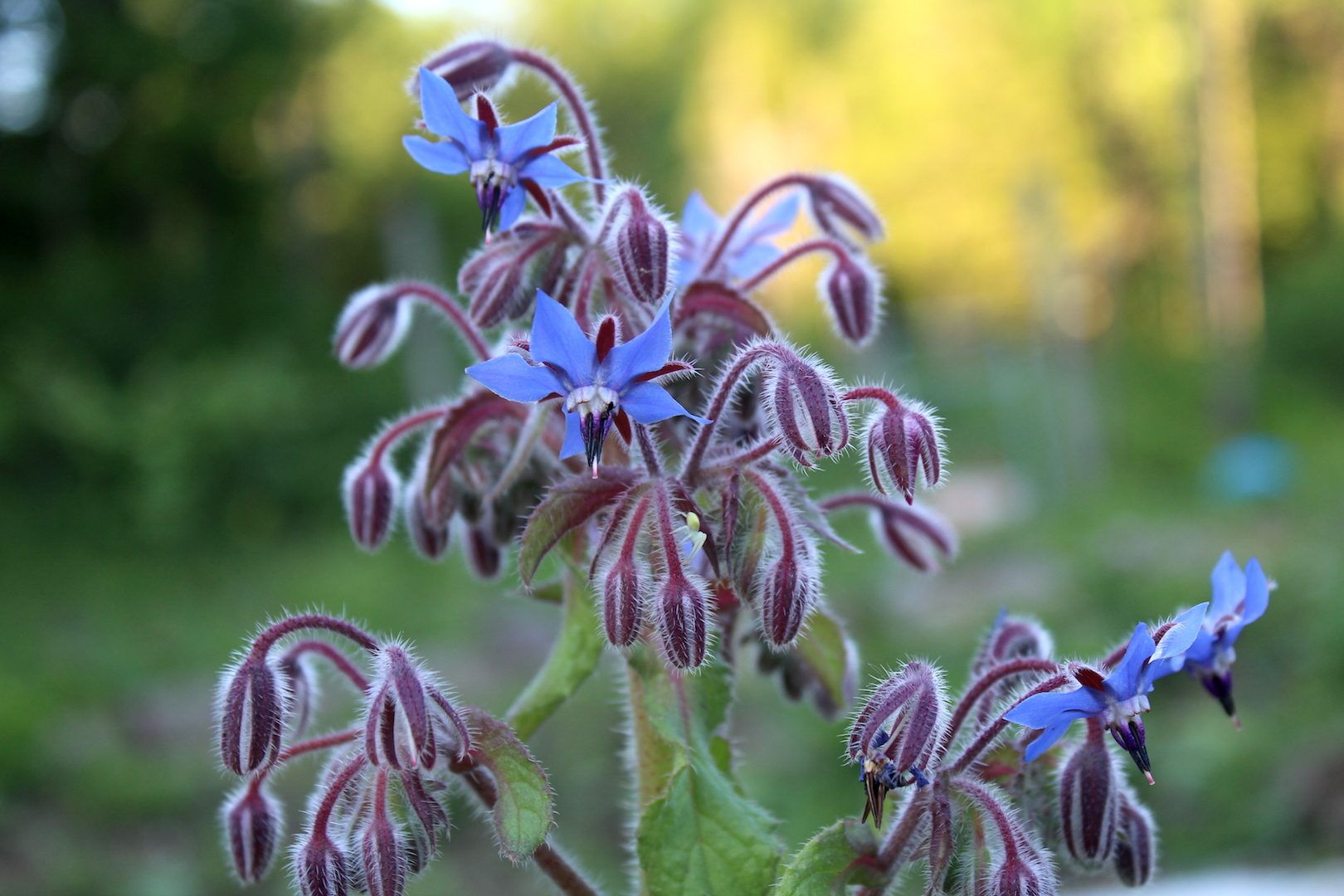
What is Borage?
Borage (Borago officinalis) is an annual herb that grows quickly but self-seeds, so it continues to reappear year after year. When you pick a spot to grow borage, make sure it’s somewhere you want it to grow year after year.
(Borage seeds are available here, from a small Vermont seed company that focuses on hard-to-find culinary and medicinal herbs.)
In the summer months, borage plants bloom with small, beautiful, blue flowers that attract pollinators and butterflies to your garden. The plants have hairy, rough leaves that measure four to six inches in length.
Don’t be surprised if your plant spreads out; one borage plant reaches 12-18 inches wide. It’s easy to see how they can overtake an area of your garden after a few years of vigorous self-seeding!
For new gardeners, borage is the perfect herb to grow. It grows well in average soil with organic matter, and you can directly sow the seeds into the garden after the last frost date. If you don’t mind reseeding, the plants will continue to show up each year, which means no work for you.
To prevent self-seeding, just be sure to harvest (and use) all the flowers, or try growing borage in containers. It stays smaller that way, and it’s a lot easier to keep track of the seeds.
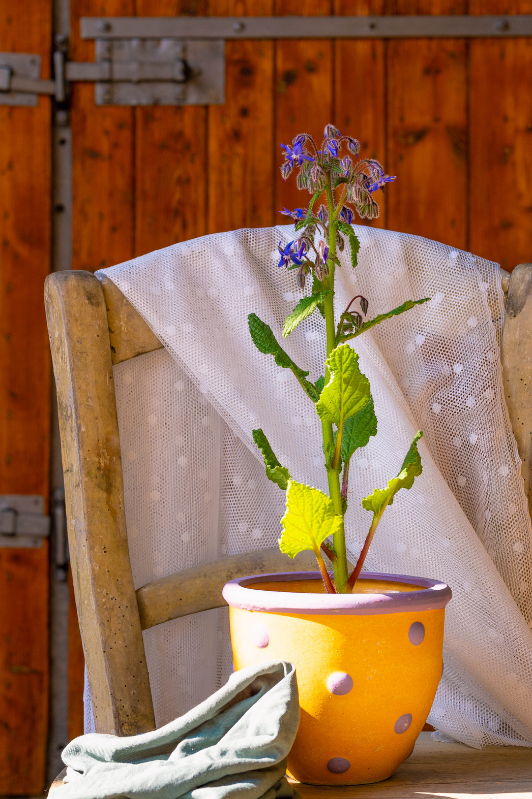
Borage Medicinal Properties
One look at the list of borage’s medicinal purposes, and you’ll wonder why everyone doesn’t grow it in their herb garden. This herb is a cooling, cleansing herb with adaptogenic, demulcent, diuretic, expectorant, and anti-inflammatory properties.
All parts of the borage plant contain medicinal properties. The flowers are the most commonly used part, but the leaves and oil from the seeds are useful if you want to create herbal remedies.
Oil from the seeds is sold as a popular borage oil herbal supplement, and it’s a plant-based source of Omega fatty acids.
Herbalists use borage to treat a variety of ailments, such as:
- Eczema
- Rheumatoid Arthritis
- Stress
- Premenstrual Syndrome
- Diabetes
- Attention deficit-hyperactivity disorder
- Acute respiratory distress syndrome
- Asthma
- Heart disease
- Strokes
- Fevers
- Cough
- Depression
Growing borage in your herb garden gives you a potent, versatile medicinal herb, but personally, I love it most as a culinary herb for its delicious flowers and leaves.
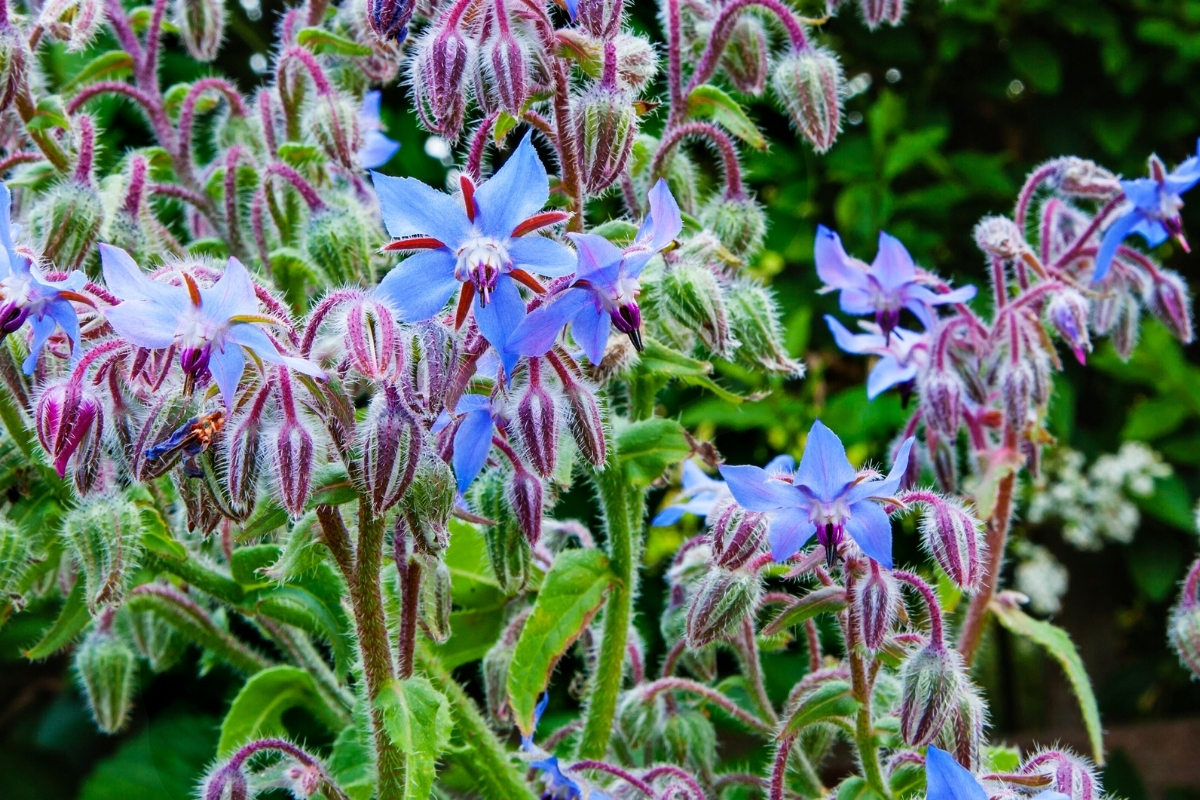
Ways to Use Borage
You’ll find many ways to use borage once it grows in your garden. Here are some medicinal and culinary uses for this lovely herb.
Borage Tea
Borage tea has many uses. It helps treat nervous conditions, and tea made out of borage leaves stimulates lactation in breastfeeding mothers. Herbalists use borage tea to reduce fevers, relieve stress, and stop coughing.
Borage tea is best made out of fresh leaves and flowers. You need around ¼ cup fresh borage leaves or flowers and one cup of hot, boiling water. L
et the tea blend steep for 10-15 minutes, and use honey to sweeten to the taste you prefer.
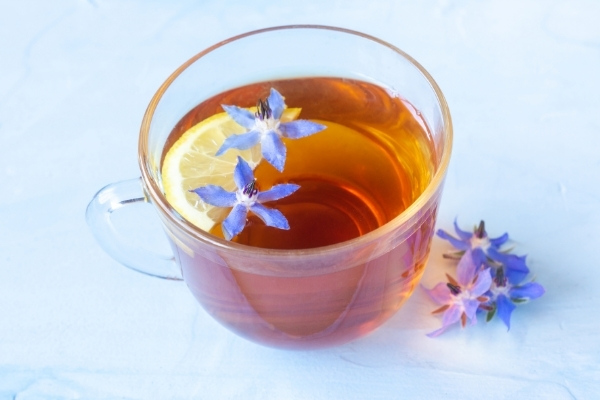
Borage Tincture
Making a borage tincture is the same as making any other herbal tincture. Start by filling a glass jar with borage flowers, packing them tightly into the jar. Then, fill the jar with vodka or whatever alcohol that you prefer.
Seal the jar and keep it in a cool, dark, dry location for two to six weeks. When it’s time, take the jar out, and strain all of the flowers out of it.
Now, you have a homemade borage tincture, which is a shelf-stable medicinal extract that can be used year-round (even when borage is not in season).
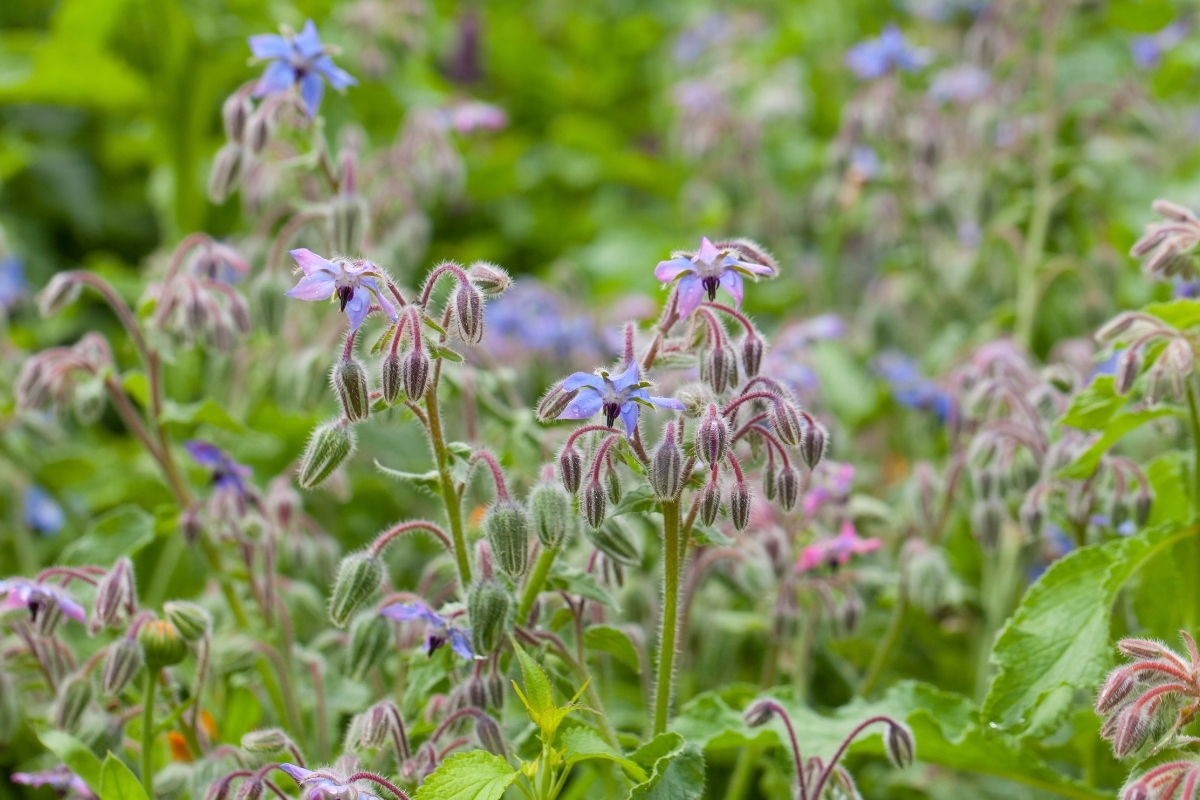
Borage Infusion
Making an infusion with borage is so easy.
All you need is a quarter of a cup of bruised, fresh borage leaves. Pour one cup of cool water over the top of the bruised leaves and let it soak in the refrigerator for a few hours (or overnight).
After steeping, strain it, and you have a simple infusion that’s cooling, and refreshing on hot summer days.
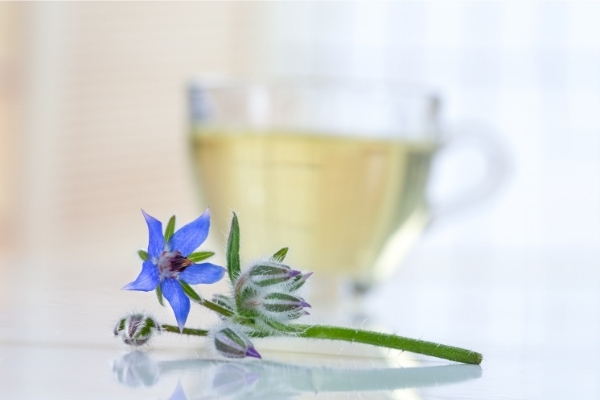
Borage Poultice
A crushed borage poultice helps with bug bites, bee stings, swelling, bruising, rashes, and boils. It’s a useful, versatile herbal remedy to have up your sleeve, especially in the summertime when bug bites happen frequently.
I actually used this on my son, who was stung by a bee in the garden not too far from our patch of borage.
Start by gathering enough fresh borage leaves and stems to cover the area that you need to treat. Once you learn how to make a poultice, just apply the medicine and use cotton gauze to keep the poultice in place while it works.
In my case, I just quickly chewed the leaves in the garden and placed them directly on the sting.
A borage poultice works fast. You’ll quickly feel the soothing effects that help reduce skin inflammation, just be sure to get the stinger out first if it’s still in the skin.
Borage Infused Oil
The most popular type of borage oil is borage seed oil, but you can make a herbal infused oil out of the flowers. The same process that you might use for other herbs works for borage a well.
Start by picking enough borage flowers to fill a glass jar, and spread them over a baking sheet or screen. Let the flowers dry for several days, and then put them back into the glass jar. It’s important to let them dry beforehand to reduce the risk of spoiling or mold developing.
Fill the jar with olive oil, and let it sit for four to six weeks. Remember to shake it up every few days. After the time is up, strain out the flowers, and you have DIY borage-infused oil.
You may use this oil on your skin for irritation and rashes, or you can use it to create homemade herbal salves and ointments.
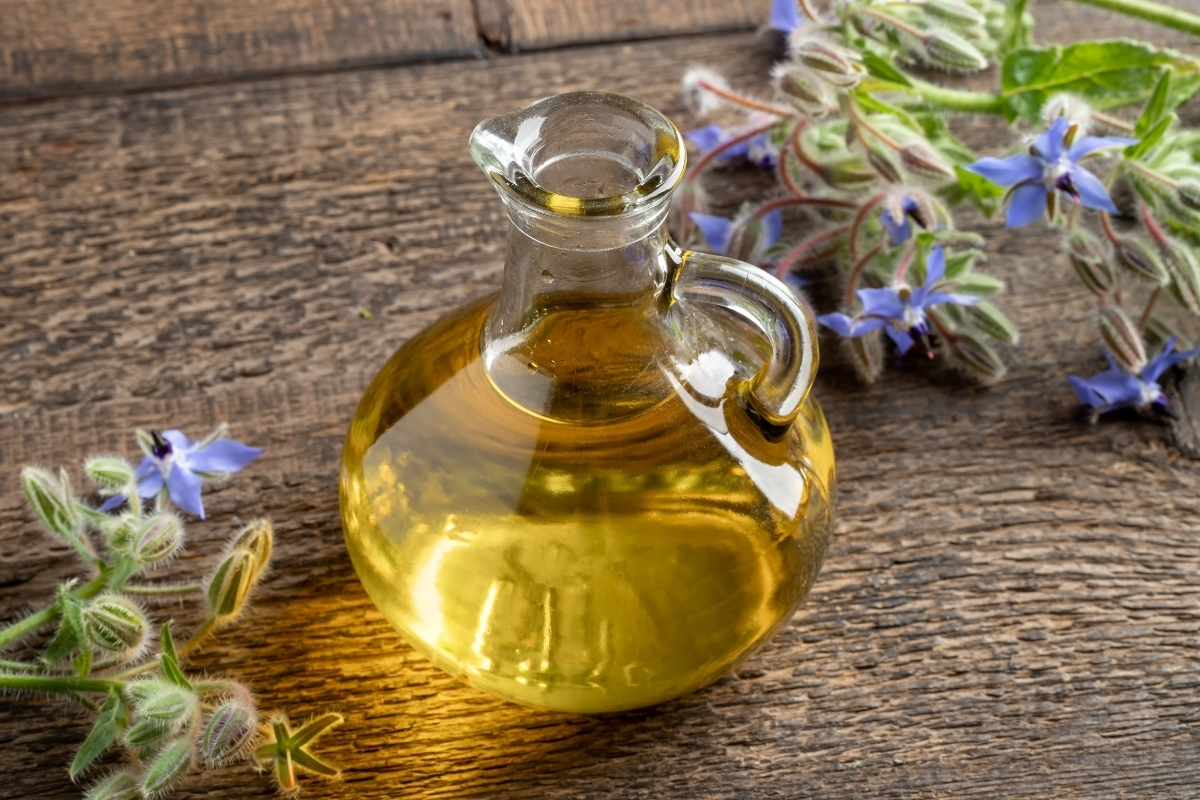
Borage Salve with Calendula and Lavender
This recipe combines three potent, healing herbs to create the perfect salve for skin problems. You can use hemp or olive oil for your calendula, lavender, and borage salve. This method creates an infused oil much faster than the traditional method, but the quality stays the same.
Use beeswax pastilles to make a salve after the infused oil is ready.

Cucumber Borage Soap
I love cucumber soaps; the smell is so refreshing and makes your skin feel better. The mixture of cucumber and borage is perfect for those suffering from skin irritation, bug bites, inflamed skin, or eczema.
Take a look at this easy cucumber borage soap recipe.
Borage Recipes
Beyond borage’s medicinal and cosmetic uses, it’s also just a tasty edible herb. The leaves can be eaten like spinach, and it makes delightful soup.
Though it’s eaten like a cooking green (or salad green), the leaves actually taste more like cucumber than lettuce or spinach.
The flowers have a milder flavor and are best fresh. The leave can be eaten fresh or cooked, and the stems are best cooked in my opinion.
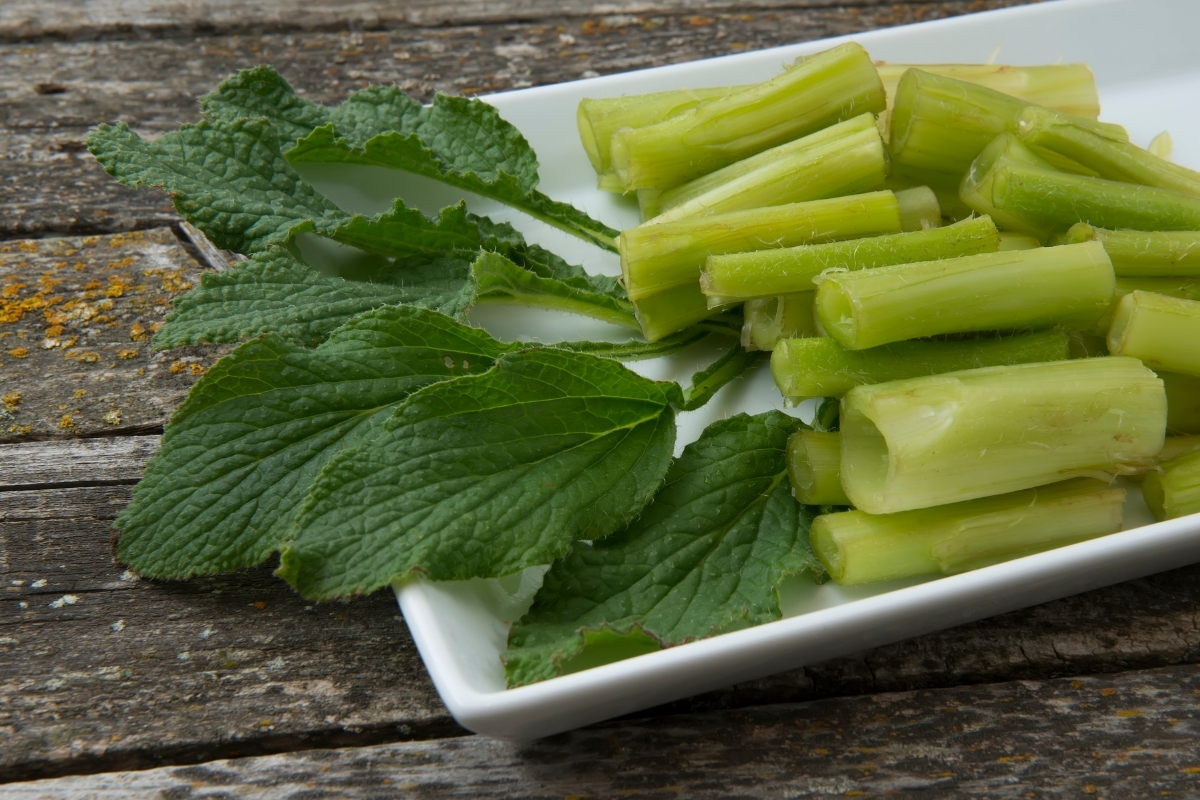
Borage Cucumber Jelly
This jelly recipe is showstopping and delicious. To make borage cucumber jelly, you need six cups of borage leaves and flowers and one cucumber juiced. The recipe is easy enough that those who are new to canning will be able to make it.
Since borage has a natural cucumber flavor, the mix is sweet and refreshing.
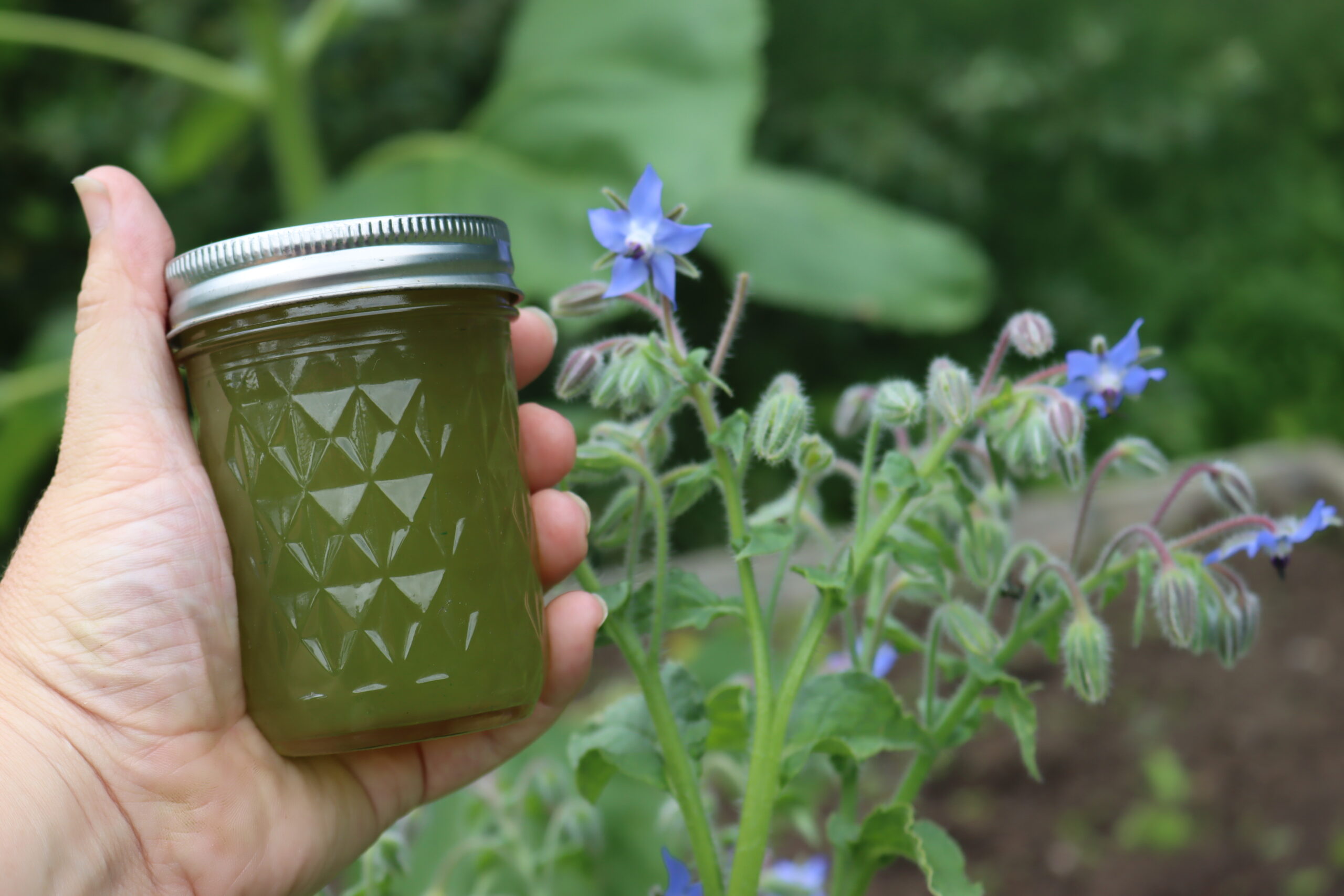
Ravioli Filled with Borage and Ricotta Cheese
Most people focus on using borage flowers instead of the leaves, but the leaves make an excellent substitution for spinach. It only takes 30 seconds to blanch the leaves in salted water.
Try adding the leaves to your ravioli filling instead of spinach. Borage leaves add a bit of a cucumber-like flavor to the ravioli, but it’s only a hint.
Borage Soup
If you have an excess of borage leaves, try making borage soup, which you can serve hot, cold, or room temperature. Borage leaves have a light cucumber flavor that makes the perfect base for soups.
This soup needs a lot of borage leaves, so it’s perfect towards the end of the summer when the plant is nearing the end of the season. You need up to 2lbs of borage leaves or a mixture of greens and leaves to give this recipe a try.
Borage Leaf, Pea, and Garden Mint Soup
If you loved the first borage soup but want to make it a bit fancier, the recipe for borage leaf, pea, and garden mint soup is everything. The borage gives the hint of a cucumber flavor that works well with peas and mint.
This soup would be perfect on a cool spring evening with some homemade bread.
Borage Mint Dip
Say goodbye to the classic cucumber dips you find at parties and try a borage and mint dip instead.
Borage brings the sweetness, and the mint brings the refreshing flavor that you need with a dip. Serve this dip with some crudites, and it’ll be a party favorite. Plus, it’s the perfect way to use up all of those borage leaves you have in the garden.
Borage Lemonade
Want a refreshing drink this summer? Look no further than borage lemonade. All you need is a few fresh borage leaves and homemade lemonade.
The leaves need to be mixed with lemonade, adding a hint of cucumber to your drink. It’s unique without being too strange. Add a few borage flowers to the top of the drink for decoration.
I have friends who actually freeze individual borage flowers into ice cubes and use them in their summertime lemonade (mixed drinks too), so you can get creative.
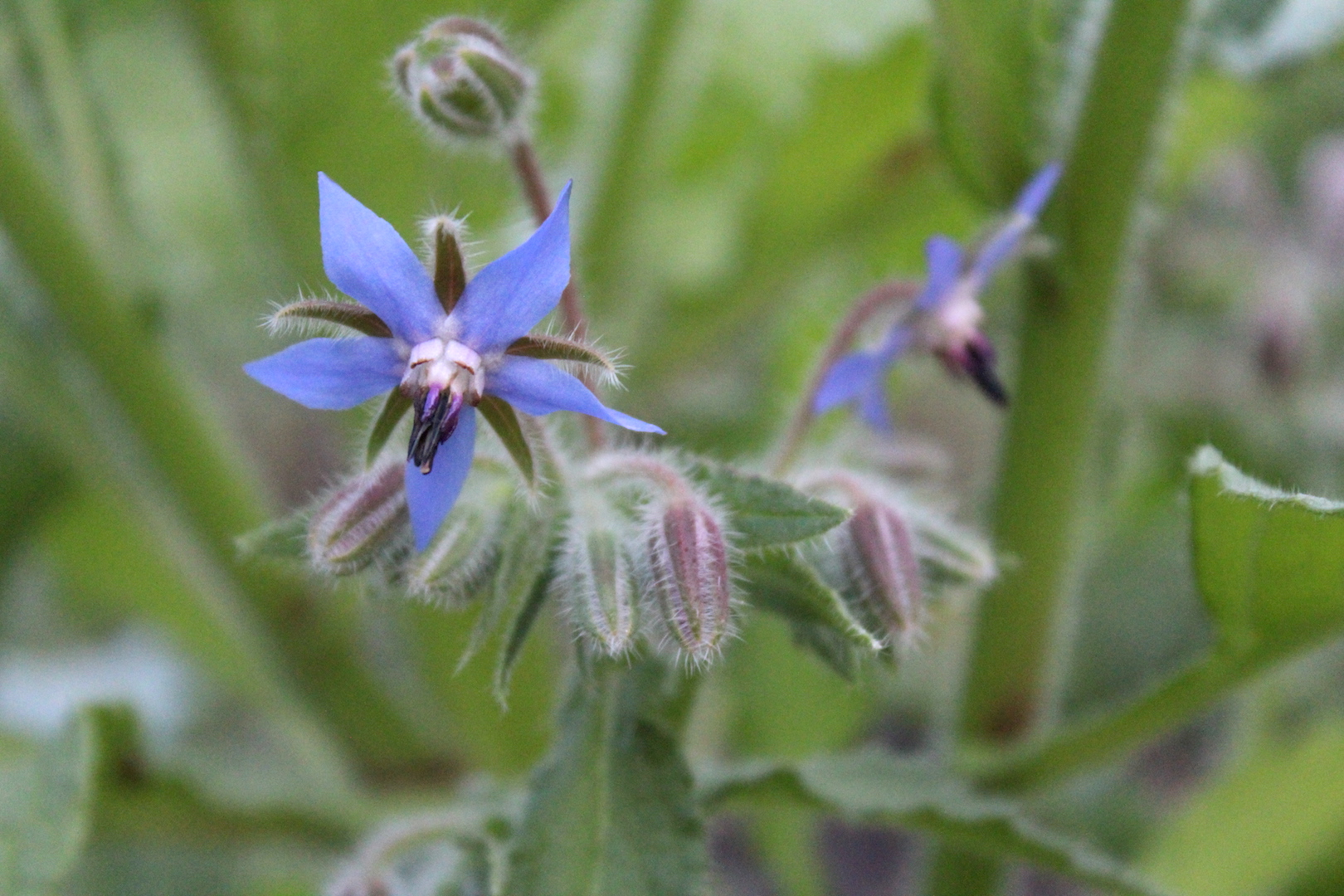
Other Uses for Borage
Besides its medicinal and culinary uses, it’s also just handy around the house and for beneficial insects.
Plant Borage as a Pest Deterrent
Borage is one of those plants that naturally repel pests due to its strong aroma. I think the aroma is pretty mild, but I’m not a garden pest! For some reason, they steer clear of borage.
If you often have problems with tomato hornworms, plant these near your tomatoes. Not only do they help repel these plants, but borage is also a companion plant for tomatoes and helps with pollination.
Attract Beneficial Insects
Another way that you can use borage in your garden is to attract beneficial insects and pollinators.
Honeybees, bumblebees, and butterflies love those pretty, bright, blue flowers. Grow borage in pots near your vegetable garden or along a fence close to your fruit trees.
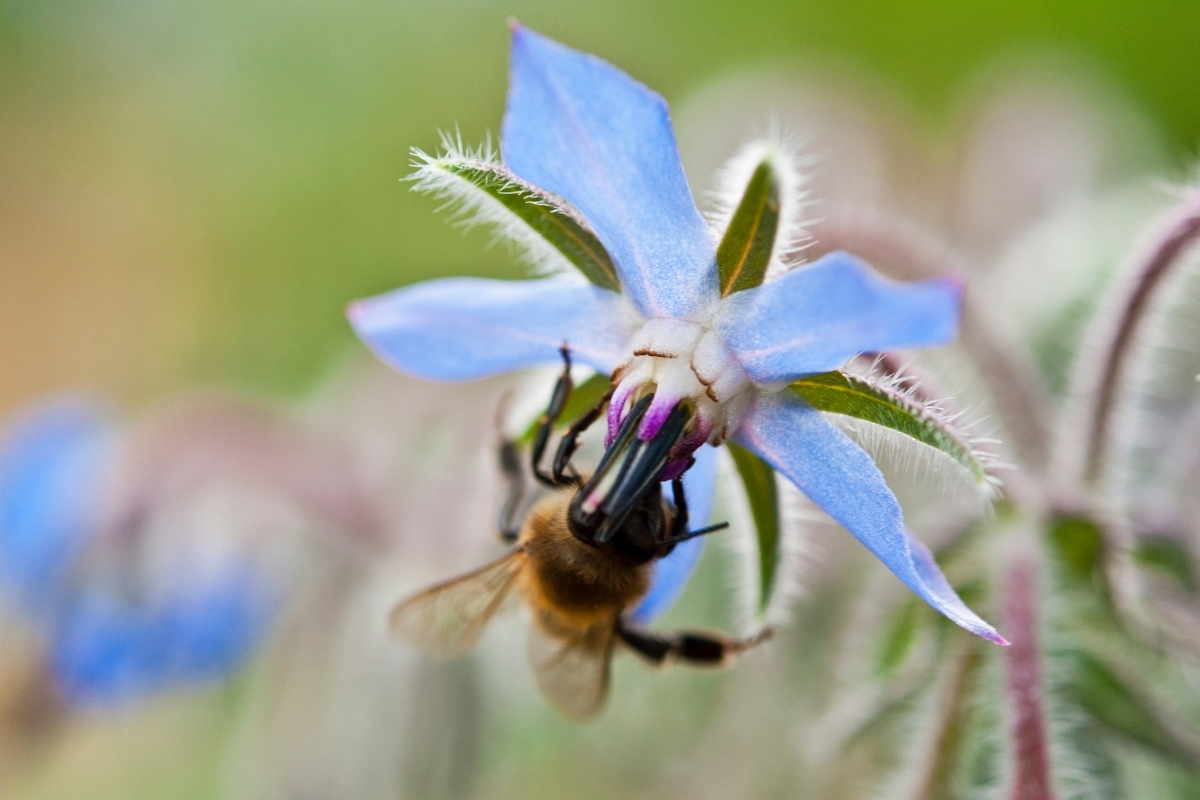
Herbal Guides
Looking for more creative ways to use homegrown herbs?
- 50+ Ways to Use Yarrow
- 60+ Ways to Use Dandelions
- 12+ Ways to use Bee Balm
- How to Eat a Rose (and Rose Remedies)
- Using Red Cover for Food and Medicine
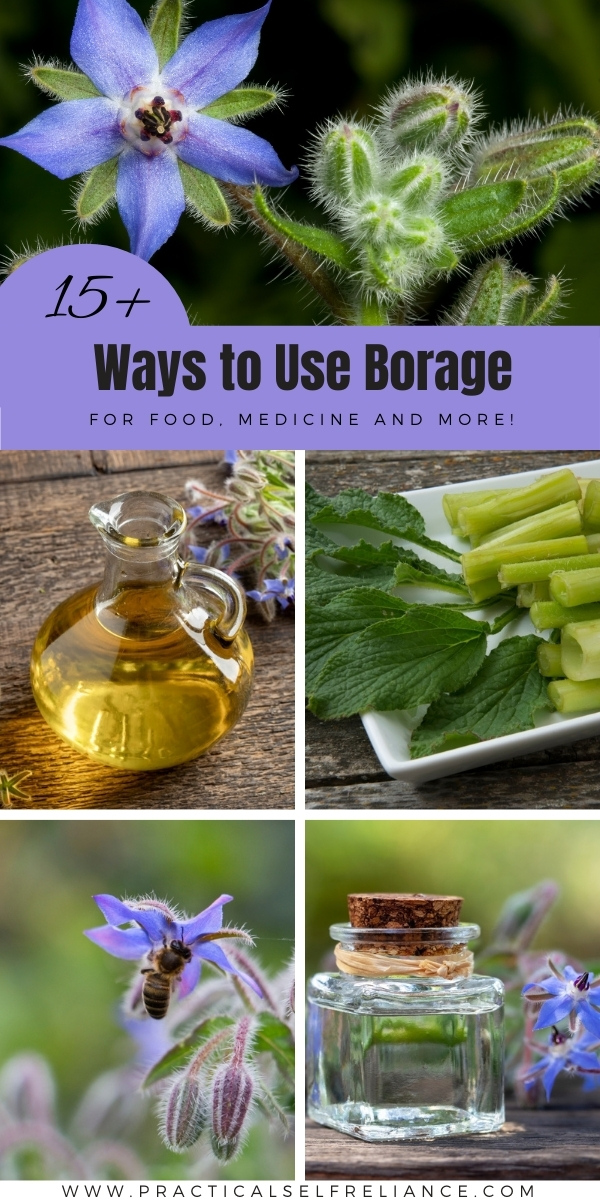


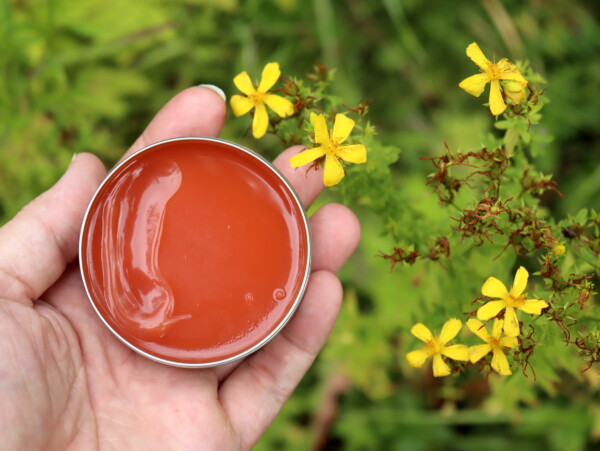
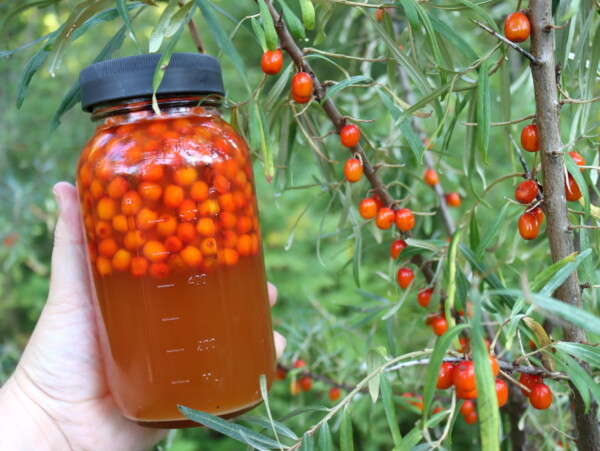










A heartfelt thank you! 💖
I ordered Borage seeds and I now have comfrey plants are these the same plant?
Thanks
No these are two totally different plants.
Can you make the tincture our of the leaves too or just the flowers?
All parts of the plant have medicinal properties and can be used.
I like using Borage leaves for bee stings as I have a son who just can’t stop trying to touch them! What would be the best way to keep some year around. Would tincture work? Thank you!
A tincture would work. You could also try drying the leaves and then making a paste out of it.
Hi, I seed started Borage this summer and my plants have grown humongously! I am wondering if you have any homemade soap or face cream recipes that would be beneficial using Borage- I am still confused with what parts of the plant are to be used in recipes. Can flower buds that still have green seeds inside be used or do I wait until the seeds are brown and dropped out- or is that too late? Do I use only the fresh, blue flowers or if they dropped or start to wither can they still be used?
Thank you for your amazing information and site. I love all this great information, photos, and recipes! Thank you for sharing!
When you are using any flower for something like this you usually want to use flowers that have just opened. There is a soap recipe linked in the post and if you are wanting to make face cream, you can follow the directions in the post for an oil infusion and then use that oil infusion in your face cream recipe. You can find lots of good soap recipes and recipes for facial creams at http://www.thenerdyfarmwife.com
Oh, interesting. I have never heard of this before.
Is there any way to have a pdf of this info so I can print it?
I’m sorry but we don’t have any PDF files available.
Hi, Ashley. Can you help resolve the confusion whether borage seed oil drops (USDA certified organic) is okay, even in one drop diluted with other oils or foods, to consume orally, or if it is dangerous to consume orally?
Here is a previous response to someone with the same question that might help.
Interesting…I’d honestly never heard anything of the sort for Borage. Nothing is mentioned in any of my herbalism books to that effect, nor are any cautions mentioned anywhere I looked putting this article together. I did a bit of research after seeing your note looking for information on this, and I did find one study that’s a literature review concerning potential toxicity. It’s a review of instances of toxicity among coltsfoot, comfrey, and borage. While coltsfoot and comfrey do have instances where people taking them for (especially for longer periods) have had issues, there were no reported issues with borage. Study here: https://www.sciencedirect.com/science/article/pii/S0367326X20301015
As with any herb, it’s probably best to avoid consuming large amounts, and it seems like there’s been very little specific research into borage. It does have a long history of use in food and medicine, but that obviously is no guarantee that it’s harmless.
I ordered seeds to grow this stuff. I am so interested in healing herbs. Never grew them before. I was reading this stuff can cause cancer if it has high levels of something in it. So how do you know if it’s ok to use? Haha
As with any herb we always recommend doing your own research and then using your best judgement on which herbs to use and how much. This question was actually addressed previously in Sarah’s question earlier this year. Take a look at Ashely’s response and let us know if you have any other questions.
When making anything with the flowers (infusion, maybe) can I use buds that haven’t yet opened? Thanks!
I have seen some places that say to harvest right before they open or right when they first open.
Do not eat borage, Borago officinalis. It is a poisonous plant! Those flowers are poisonous too!
Here is Ashley’s response to a previous comment regarding the toxicity of borage:
“Interesting…I’d honestly never heard anything of the sort for Borage. Nothing is mentioned in any of my herbalism books to that effect, nor are any cautions mentioned anywhere I looked putting this article together. I did a bit of research after seeing your note looking for information on this, and I did find one study that’s a literature review concerning potential toxicity. It’s a review of instances of toxicity among coltsfoot, comfrey, and borage. While coltsfoot and comfrey do have instances where people taking them for (especially for longer periods) have had issues, there were no reported issues with borage. Study here: https://www.sciencedirect.com/science/article/pii/S0367326X20301015
As with any herb, it’s probably best to avoid consuming large amounts, and it seems like there’s been very little specific research into borage. It does have a long history of use in food and medicine, but that obviously is no guarantee that it’s harmless.”
I’ve been searching for a more Information lately about the toxicity of borage (that’s how I found this article) because I love this plant and don’t want to believe it is toxic. In the studies I’ve read and the research I’ve done It is the pyrrolizidine alkaloids (PAs).in borage that can cause liver damage if ingested over time. So even taking small doses every now and then can still cause liver damage. Probably just as harmful as some pharmaceutical drugs but sadly I’ll be avoiding ingesting it from now on. Studies have also found that the PAs can be transferred to other plants growing nearby so I’m going to have to move my borage away from my tomatoes which I’ve always kept them as companions. This is very sad news!
Any chance of providing links to said studys. Without them it’s just heresay.
Referring to the toxicity of Borage. Toothpaste has a poison warning if ingested. Many products that are made specifically for humans can be toxic, but for some reason,maybe all the pretty marketing… we overlook and use the product anyway and give to our children no less.
Thank you for this! I love the cucumbery fresh taste of my raw borage leaves… but I really struggle with the prickly/hairy texture. Not fun to chew. Does cooking the leaves remote the prickles?
Like most greens that have a fuzzy or prickly texture, cooking should eliminate this issue.
Ashley,
I love and appreciate all of your info! I want to print it all. Is there a printable version?
If you click on the three dots at the top of the page you should be able to print the article although since there is no PDF version, you may get a lot of unnecessary text. You can always copy and paste the text into a new document and print it that way. Hope that helps.
Love this article I found it super informative! I have a huge borage plant and didn’t even know I could eat the leaves! Can’t wait to try some of these recipes thank you!
You’re welcome. So glad you enjoyed the post.
I’ve recently bought and started borage from seed and love your article here. However, for kicks and giggles, I looked up Borage in my Peterson Field Guide to Medicinal Plants and Herbs, and it says to steer clear of Borage because of potentially liver-toxic and carcinogenic pyrrolizidine alkaloids. It says the risk of use outweighs any benefits – so now I’m super confused and a little hesitant. Can you help and speak to any negative things you know about borage? Thank you for your site- it such a great resource!
Interesting…I’d honestly never heard anything of the sort for Borage. Nothing is mentioned in any of my herbalism books to that effect, nor are any cautions mentioned anywhere I looked putting this article together. I did a bit of research after seeing your note looking for information on this, and I did find one study that’s a literature review concerning potential toxicity. It’s a review of instances of toxicity among coltsfoot, comfrey, and borage. While coltsfoot and comfrey do have instances where people taking them for (especially for longer periods) have had issues, there were no reported issues with borage. Study here: https://www.sciencedirect.com/science/article/pii/S0367326X20301015
As with any herb, it’s probably best to avoid consuming large amounts, and it seems like there’s been very little specific research into borage. It does have a long history of use in food and medicine, but that obviously is no guarantee that it’s harmless.
Hi! I know I’m replying about a year late, but I wanted to add that if ever you see a “natural/field medicine” book telling you NOT to use herbal remedies that you can grow yourself, be sure to look at who sponsors the book and what the author does for their main job. The professionals who say “don’t use herbal remedies” are the ones getting paid by pharma companies to sell their drugs to patients instead. If doctors can’t sell a patient a drug because the patient can grow their own medicine, neither the doctor or the pharma company gets extra money. Nevermind the fact that many pharma drugs directly use the main component from medicinal herbs in their own drugs, but they don’t want the patients to know that and to grow their own medicine. Healthy people don’t make the doctor or big pharma any money, and that’s the way it should be.
I just ordered some borage seeds after learning that they repel tomato pests. Also love the idea of adding some of the leaves to salad. I’m going to grow it in a flowerpot and place it next to the tomatoes so that it doesn’t overseed all over the garden….do you think that will reduce the beneficial effect?
Apparently it’s the scent of the plant that repels the pests so I don’t see why it would hurt to plant it in a container. It should still be effective.